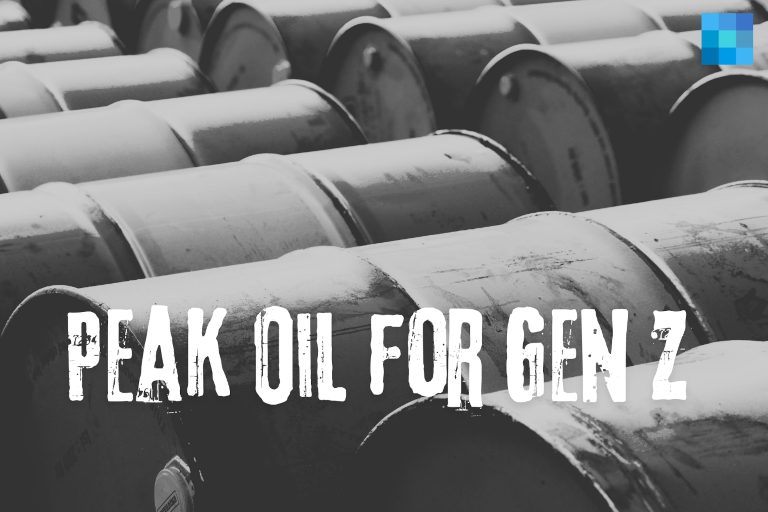
Gen Z is a generation born into a world full of anxieties—from school shootings to climate Armageddon, to a pandemic and political violence. But I’m here to give you one more thing to worry about!
A high-stakes debate about the timing of peak oil has been simmering for decades. Although few of today’s Gen Z members know much about it, their lives will be impacted profoundly by the waning of the petroleum era.
It’s helpful to revisit this subject not just because there’s a new potential audience and pool of debaters, but also because there is important news regarding U.S. and world oil production.
Since there’s a lot to convey, I’ve chosen a succinct format, Q&A. You can skip to whatever question stirs your interest. Also, each question starts with a short overview.
Photo by Kanae Kanesaki on Unsplash
What is peak oil?
Overview: Peak oil refers to the maximum rate of global oil extraction prior to its inevitable decline due to either depletion of the resource or falling demand. The term also refers to the debate about when the peak will happen.
We live on a finite planet. When we extract nonrenewable natural resources today, we reduce the amount that can be extracted in the future. Observation confirms this intuitively simple principle: over past decades, individual oilwells, oilfields, and whole oil-producing countries have become depleted and no longer yield economically significant amounts of petroleum.
Typically, in an oil-producing region, extraction starts slow, builds up to a peak as more wells are drilled, and then declines as the cost of accessing what’s left inevitably rises. Drillers naturally target the highest-quality and easiest-to-get resources first, leaving lower-quality and harder-to-get resources for later. Usually, the peak of production occurs when roughly half of the total oil that will eventually be extracted is gone.
Since oil is mostly useful for its energy content, we must account for the energy required for drilling, refining, and transporting oil. If these energy costs approach or exceed the amount of energy obtainable from the oil being extracted, the exercise becomes economically pointless. In all older oil wells and oilfields, oil is left in the ground after drilling and pumping cease simply because extracting more of it would take too much money and energy.
The peak oil discussion is not about completely “running out” of oil; that will never happen. But global society currently burns through over 83 million barrels of crude per day, and that can’t go on forever. (By the way, “oil” can be defined as “crude” or more broadly as “crude plus condensate” [C+C] or even “crude plus condensate plus natural gas liquids” [C+C+NGLs]; if you use the most generous definition, world oil production now exceeds 100 Mb/d).
That’s peak oil in a nutshell. But the phrase “peak oil” also refers to a debate that reached its own peak 20 years ago—a debate about when global oil production would hit its maximum rate and start to fall. Some scientists, looking at the data, concluded that world oil discoveries were not keeping pace with extraction, and that the peak would occur in the early 2000s. Other geoscientists, and most economists, argued that new technology would enable world oil extraction rates to continue climbing for decades to come. (Who was right? See question 3.)
Photo by Nguyễn Hiệp on Unsplash
Why is peak oil important?
Overview: The modern industrial world was built with cheap fossil energy, primarily oil. Peak oil could mean the end of growth-based economics and consumerism. Humanity will have to adapt to using much less energy—as it did for thousands of years prior to the last century or two.
Because energy is everything. Energy is what enables us to do anything whatever. Fossil fuels are energy-dense, representing tens or hundreds of millions of years’ worth of stored ancient sunlight. One barrel of crude oil, currently trading at around $65, represents the energy equivalent of riding a bike hard for 8.6 years (with breaks for weekends and holidays). That’s why the advent of the petroleum era—which was made possible by the invention of better drills and pumps, as well as engines that could turn the stored energy of oil into useful work—revolutionized society.
Since the start of the fossil fuel era two centuries ago, human population has exploded 800 percent and so has global per capita energy usage. Life today in a typical city looks profoundly different from daily life in 1820. We tend to attribute this difference mostly to technological innovation, but modernity would never have happened without an unprecedented abundance of energy (most tech inventions are ways of using, not producing energy).
Oil plays a pivotal role in modern society, providing over 90 percent of all transport energy. Petroleum’s constituents and related hydrocarbons (methane, butane, propane, etc.) are useful also as feedstocks for producing plastics, paints, fabrics, and medicines. Nearly everything we typically see in a modern city is there because of fossil fuels, and mainly oil.
In recent decades, the rapid growth of energy from fossil fuels enabled an equally rapid growth in human economic activity. Societies became dependent on growth to provide jobs for a growing workforce and returns on investment for an expanding investor class. Today, every politician, regardless of party or ideology, promises more economic growth. But more growth requires a continued increase in energy. Imagine the chaos that could ensue as the rate of oil’s flow diminishes. If we can’t get the economic growth we’ve gotten used to, if the price of oil and other fossil fuels becomes volatile and less predictable, we could enter prolonged recessionary times.
Peak oil is therefore a profound challenge to modern industrial societies. In fact, modernity may be unsustainable unless alternative sources of energy can replace oil (and other fossil fuels) at scale and in time to prevent a substantial reduction in available energy. (See question 6.)
Photo by Sankalp Mudaliar on Unsplash
Wasn’t the “peak oil theory” disproven?
Overview: Forecasts that the world’s oil extraction would peak during the early years of this century were wrong. Oil extraction grew. However, conventional oil flow rates flatlined and almost all growth has come from unconventional oil, mostly U.S. tight oil from fracking. This temporary abundance led many energy analysts to focus instead on forecasting peak oil demand, due to the adoption of electric vehicles and renewable energy.
The basic principles and dynamics of resource depletion are unarguable; however, some forecasts for when the global petroleum extraction rate would peak and decline failed.
During the first decade of this century, many books, websites, and documentaries about peak oil appeared, and the topic achieved notoriety. The furor was tied partly to the immediacy of the claims: many forecasters said that global oil production would peak very soon—before or around 2010. As that date came and went, public interest understandably waned. The forecasts were too specific, since data were open to alternative interpretations; also, pessimistic analyses were based on conventional oil only, with the potential role of unconventional oil largely dismissed (more about this below).
At the same time, climate change was becoming the overarching issue of environmental policy. Climate activists argued that the world’s problem was too much oil, not too little, and that renewable sources of energy could fully substitute for fossil fuels, and soon.
However, the main reason for the loss of public interest in peak oil was the fracking revolution. New drilling technologies (hydraulic fracturing and horizontal drilling) made it possible for petroleum companies to target oil trapped in rocks with low permeability, often shale (the resource is known as “light, tight oil” [LTO] and is one type of unconventional oil). Tight oil extraction requires high rates of drilling, because individual wells deplete quickly; it therefore also requires lots of investment capital. The fracking revolution likely wouldn’t have happened without the economic context of low interest rates, which resulted from the 2008 financial crisis (which itself was linked to high oil prices). Nevertheless, the results have been spectacular: U.S. oil extraction has risen from 5 million barrels per day in 2010 to 13.4 Mb/d today and now leads the world.
World conventional crude oil extraction plateaued in 2005, approximately when many peak oil analysts forecast that it would cease its long ascent. However, since then energy markets have been well supplied with unconventional oil to meet rising demand.
The peak oil discussion didn’t entirely go away; it was largely reframed as peak oil demand (as opposed to peak supply), based on the assumption that adopting alternative energy sources and electric vehicles would soon reduce society’s dependency on crude. But, as we are about to see, the argument for peak supply may be primed for a comeback.
Photo by Werzk Luuuuuuu on Unsplash
What’s new in the peak oil debate?
Overview: Government and industry sources say that tight oil extraction in the U.S. will peak soon. If it does, there are few options left to keep the global extraction rate from falling.
U.S. tight oil was always going to be a short-term energy source for society, as we at Post Carbon Institute argued in a series of technical reports and a short book. Today, data show that American tight oil production is close to peaking. In effect, the oil patch is all drilled up with nowhere to go.
This is not just our interpretation. The Energy Information Administration (EIA, an office of the U.S. Department of Energy) expects American oil output to begin falling after next year. The most productive tight oil region, the Permian play in Texas and New Mexico, is the last of the major regions to peak, and it is looking peakish indeed. Petroleum geologist Art Berman explains, “The plays have been over-drilled and wells are interfering. They are cannibalizing production from each other.” Once that pattern fully takes hold, overall extraction rates cannot be maintained.
Oil company executives, who in the past tended to dismiss the peak oil discussion, are now openly talking about a near-term shale peak. Travis Stice, the chair and CEO of Texas-based Diamondback Energy, recently told investors that it is “likely that U.S. onshore oil production has peaked and will begin to decline this quarter.” Occidental Petroleum CEO Vicki Hollub told the industry conference CERA Week in March that her company expects a peak in U.S. production sometime between 2027 and 2030, but more recently said that growing economic uncertainty means “it’s looking like [the] peak could come sooner.”
Politics isn’t helping. U.S. President Donald Trump has promised to ease the way for the American oil industry to significantly increase production and thereby reduce gasoline prices for motorists. The administration is seeking to open millions of acres of public land to oil and gas drilling—which would have far-reaching environmental consequences. Trump’s newly politicized Department of Energy now blames former President Joe Biden’s policies for charting a “disastrous path” for American energy production. However, U.S. oil output set new records under Biden’s presidency, and more new drilling permits were issued during Biden’s term than in Trump’s first term. Trump’s policies may ironically hasten a decline in U.S. oil extraction. His sweeping tariffs against American trading partners are raising costs to drillers for steel and equipment, according to the Paris-based International Energy Agency (IEA). Further, lower oil prices (a stated goal of Trump policies) would incentivize tight oil drillers, whose costs are already high, to reduce drilling operations.
If U.S. tight oil is peaking, the country’s natural gas produced by fracking (often called shale gas) will likely be close behind. Natural gas is used mostly for electricity generation, as a heating fuel, and as a chemical feedstock. American gas production, like conventional oil production, was headed downhill until the adoption of fracking, which boosted the country’s gas output dramatically, and now accounts for 80 percent of total extraction. But shale gas suffers from the same constraints as tight oil—rapid depletion of individual wells and the requirement for high rates of drilling. According to resource consultants Goehring & Rozencwejg,
“The great gas fields of the shale era have already whispered their farewells. The Marcellus in Pennsylvania—still the heavyweight of American gas—topped out at 27.8 bcf/d in late 2023. It now sits 1.2 bcf/d, or roughly 5%, below that high-water mark. The Haynesville, a once-bustling engine of supply in Louisiana and East Texas, crested at 14.7 bcf/d in May of last year; it has since fallen by 2.6 bcf/d—nearly 20%. Only the Permian Basin, clocking in at 20.2 bcf/d, has yet to exhibit clear signs of decline. But we believe that, too, is merely a matter of time.”
G&R expect the peak of U.S. shale gas output to occur between 2027 and 2030.
If there’s anything to be learned from the peak oil discussion of the early 2000s, it’s that forecasts are problematic. We simply cannot know exactly how all the relevant variables will interact. Just one example: oil extraction rates depend somewhat on oil prices. When prices are high, drillers expand operations; when prices drop, drillers idle rigs. Currently, oil prices are at the low end of profitability for shale drillers. Prices could rise, thereby incentivizing more drilling and, for a while, higher extraction rates; however, if the U.S. economy is headed toward slower growth or recession, as many analysts believe, oil prices might fall.
Nevertheless, regardless of prices, it’s clear that the oil and gas industry is approaching an inflection point where more drilling may not translate to increased supply the way it used to.
Photo by Yiquan Zhang on Unsplash
Is global peak oil nearly here?
Overview: World peak oil is probably upon us. There is some uncertainty due to oil prices: if prices go higher, drillers will deploy more rigs and the peak could be put off for a few years. But the easiest-to-get and most profitable oil is already gone.
As discussed in (3) above, world conventional oil extraction rates have been on a bumpy plateau since 2005 (though with a temporary uptick around 2016). Most new production has been from tight oil, oil sands in Canada, and deepwater oil in Brazil. Without the fracking revolution in the United States, world oil supply would barely have increased in the past 20 years. That begs the question: if U.S. tight oil extraction is peaking, and if the long conventional oil plateau ends soon in a decline, how will the world keep petroleum output growing? Conventional oil production in a long list of countries (including Angola, Mexico, Norway, and Russia) is either already declining or set to decline in coming years.
Some countries are increasing their extraction rates. A few, like Argentina, are employing fracking technology (though no country is poised to repeat the U.S. miracle). Other countries increasing extraction include Brazil, Canada, and Guyana. But the total increases are barely able to balance declines in other oil-producing nations.
Again, higher oil prices would stimulate more drilling, but declining energy return on the energy invested in drilling will be the ultimate limit on world oil.
Photo by Chelsea on Unsplash
Aren’t renewables riding to the rescue?
Overview: Yes, solar and wind electricity generators are being installed at record rates, but not nearly sufficiently to forestall the likely economic impacts of peak oil.
Renewables now account for 40 percent of U.S. electricity generation (though a good share of that is hydro, which was already a major power source before solar and wind started growing significantly in the last couple of decades). However, electricity represents just 20 percent of all energy usage. The other 80 percent—which includes most transportation, heating, and manufacturing energy—will be challenging to electrify.
A full replacement of fossil fuels with renewables-sourced electricity confronts a problem of scale: the world uses vast amounts of energy, and past energy transitions were additive rather than a replacement of one source with another (we still use as much firewood as we did before our adoption of fossil fuels). Further, economic growth requires ever more energy usage. So far, annual growth in energy demand has surpassed the amount of new energy coming from renewables, with the result that fossil fuel usage and greenhouse gas emissions are still increasing despite the cumulative global investment of trillions of dollars in solar and wind power.
There is also a materials problem. Solar and wind power generators and their batteries require an array of minerals, including sand, copper, nickel, lithium, and rare earth elements. Vast quantities will be needed also for new industrial equipment that runs on electricity rather than carbon-based fuels. The World Bank, the IEA, the IMF, and McKinsey and Company have all issued reports warning that supplies of these materials will be insufficient unless mining expands dramatically. But new mines are often located in ecologically sensitive areas or regions stewarded by Indigenous peoples.
World demand for oil could wane as electric vehicles replace vehicles that burn gasoline and diesel fuel. In 2024, 20 percent of all new cars sold globally were EVs (though the EV growth trend is faltering in Europe and the U.S. due to expiration of government incentives). China leads in EV manufacturing, but its industry is plagued by low profitability. EVs still represent only about 4 percent of the existing world passenger car fleet.
Taking all these trends into account, most economists conclude that peak oil demand is still years away.
Photo by Syd Wachs on Unsplash
What’s the take-away message of peak oil?
Overview: Because the industrial way of life depends on a temporarily abundant energy source that will be hard (if not impossible) to replace, it is inherently unsustainable. Start now to look for ways to reduce energy dependency and become more self-sufficient.
There are actually a few take-aways.
Oil depletion will likely deliver a future very different from the never-ending ramp of economic growth and technological progress that most economists and politicians have promised. Energy may become scarcer, and, as a result, everything may be harder to do. It’ll be up to us to negotiate which activities we’ll reduce and which we’ll maintain, and which segments of the population will shoulder more of the burden of adaptation or suffering. Will society prioritize food, shelter, and health care? Or will it sacrifice these to profits and to the rapid deployment of AI?
Once one starts looking at the world in terms of depletion, it eventually becomes apparent that industrial civilization is unsustainable on many fronts. The ways we currently use energy and materials cannot be maintained far into the future. We must adopt simpler and more modest ways of living on the planet.
Peak oil will not solve climate change. Even if oil extraction rates start declining immediately, there is enough recoverable oil (and coal and natural gas) left to raise global temperatures several degrees—though there’s probably not enough fuel to justify the worst emissions scenarios of the IPCC.
In general, peak oil is bad news for our growth-addicted economy but good news for nature.
If the crises facing humanity were to be arranged in a hierarchy of importance, peak oil wouldn’t be at the top. In my humble opinion, that dubious distinction would go either to global toxification (via plastics and chemicals) or climate change. These two problems have the potential to damage Earth systems profoundly, and in ways that will require thousands or millions of years of evolutionary adaptation. Peak oil is a shorter-term problem that will mostly affect humanity (though, in the aftermath, people desperate for food and fuel might scavenge resources from forests and grasslands at unsustainable rates). But it does portend the end of growth-centered modern industrial civilization.
Peak oil calls on us to imagine a lower-energy future and to start adapting now. It’s a game-changer, and a life-changer.
Teaser image credit: Photo by Atik sulianami on Unsplash



